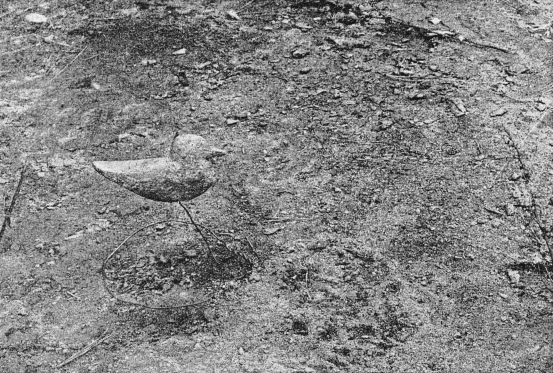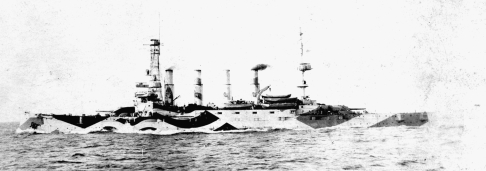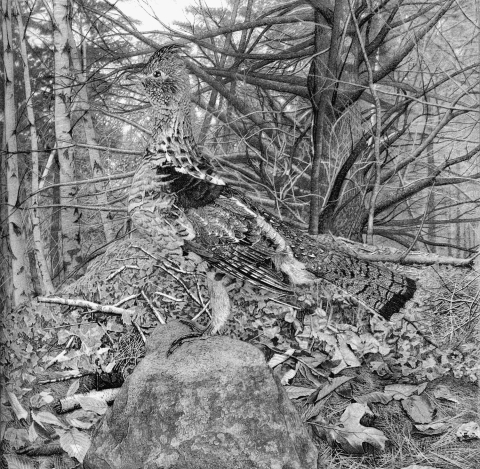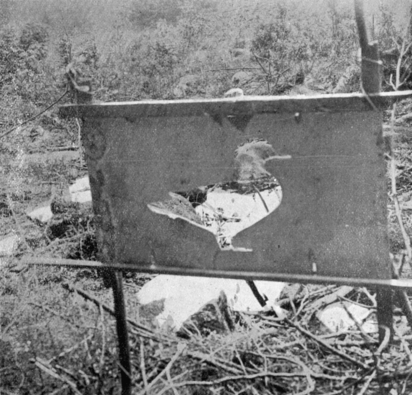Abstract
This paper reviews the achievements of Abbott Handerson Thayer (1849–1921), an American painter and naturalist whose pioneering writings on animal camouflage addressed shared concerns among artists, zoologists and military tacticians. It discusses his beliefs about camouflage (both natural and military) in the context of his training as an artist, with particular emphasis on three of his major ideas: countershading, ruptive (or disruptive) coloration and background picturing.
Keywords: Abbott H. Thayer, camouflage, countershading, disruptive coloration, background picturing
1. Thayer's influence
Among my most valued possessions are four letters from Sir Alister Hardy, the eminent British marine biologist, the first one written in 1976 and the last one 5 years later. As a young professor of art, I was researching camouflage, and having read Hardy's remarkable book, The Living Stream (Hardy 1965), I had written to him, asking about his experiences as a military camouflage officer.
In 1914, it had been Hardy's intention to enter Oxford University but he chose instead to volunteer for the British Army. In time, he was assigned to serve as a camouflage officer, or what was called a ‘camoufleur’. His father was an architect, so, as he explained to me, throughout his life, he had been
equally drawn to science and art, and if the truth be known, I must confess that it is the latter that has the greater appeal. I am lucky in not having been torn between the two; I have managed to combine them (Hardy's letter of 1976, p. 1).
He also conveyed the elation he felt as a young artist–scientist when (a few years before World War I) he read an influential book by American artist Abbott Handerson Thayer (produced in collaboration with his son Gerald, the book's author of record), titled Concealing Colouration in the Animal Kingdom (Thayer 1909). ‘Perhaps more than anyone else’, Hardy wrote, it was the Thayers who ‘drew the attention of naturalists to the importance of artistic principles in the understanding of animal and military camouflage…’ But he added this qualification,
In parts of the book they let their imagination carry them away into some absurdities as when they think the colours of flamingos help to make them inconspicuous against a sunset!… But it is a great book
(Hardy's letter of 1976, p. 1; see also Gould 1991).
There is no way to know for sure how many aspiring artists and zoologists—as Hardy—were motivated by that book. Early in World War I, the elder Thayer (according to his biographer) ‘was greatly disturbed when he heard that some of his theories had fallen into the hands of the Germans and were being used against the Allies, but he also knew that the French as well as the English had his book and were using it’ (White 1951, p. 134). More than 30 years later, in a letter to the daughter of Louis A. Fuertes (an American bird illustrator and Thayer's former student), British naturalist and artist Peter Scott, who had designed ship camouflage during World War II, nostalgically remembered that
As a boy of twelve, I spent a good deal of time studying Thayer's great illustrated book on camouflage and was much influenced by it. Later on, I became a keen duck hunter and used a duck punt that was camouflaged in accordance with Thayer's principles of negative shading,(White 1951, p. 137).
or what is now widely referred to as countershading—or ‘Thayer's law’.
2. His discovery of countershading
It is not known precisely when Abbott Thayer first realized the survival function of countershading, but we can be reasonably certain about when he began to promote the idea. Initially, he did so through informal show-and-tell—using hand-carved wooden duck decoys—and then, in April 1896, by formally writing a paper on ‘The Law Which Underlies Protective Colouration’ (in The Auk, the American Journal of Ornithology), an effect that its author described with: ‘Animals are painted by nature, darkest on those parts that tend to be the most lighted by the sky's light, and vice versa’ (Thayer 1896a, p. 125), with the result that the animal's body looks flat and insubstantial (figure 1). Decades later, the journal's editor, Frank M. Chapman, recalled the day on which he witnessed Thayer's ‘first demonstration’ of countershading:
One rainy day in the spring of 1896, wearing an old suit and rubber boots, Thayer came into my office [at the American Museum of Natural History in New York, where Chapman was associate curator] and said, ‘Come out in the square, I've something to show you’. Approaching through the mud, the contractor's house of a new museum wing then under construction he pointed to the ground near its base and said, ‘How many decoys do you see?’ We were then approximately 20 feet from the house. ‘Two’, I replied, and described them as brownish, approximately six inches long and elliptical in shape. We advanced a few feet. ‘How many do you see now?’ he asked. ‘No more’, I said, and it was not until we had reached them that I discovered there were in fact four decoys. All were of the same size, all were coloured Earth brown, exactly alike on the upper half, but the two nearly invisible ones were painted pure white on the lower half, whereas the conspicuous decoys were of the same colour throughout. Thus the comparative invisibility that constitutes protective coloration was produced not alone by colouring the decoys to resemble their surrounding (by background matching) but also by painting out the shadow that made their lower half much darker than their surroundings (Chapman 1933, p. 78).
Figure 1.
Four stages in a demonstration of countershading, from left to right: (a) a flat expanse of paper; (b) the artistic tradition of shading (or top–down lighting), by which a flat surface takes on the appearance of volume; (c) countershading, by which the undersides of animals are lighter than the surfaces that have greater exposure to sunlight; and (d) the flat expanse of tone that comes from shading being cancelled out by countershading. Author's diagram.
Chapman was greatly persuaded by this—‘One had only to see it’, he continued, ‘to become convinced of its truth and application to the colouration of animals’—so much so that he published Thayer's first paper on countershading (with photographs and a drawing) in the very next issue of the journal, followed by Thayer's ‘Further Remarks’ in the October issue (Thayer 1896b). Thayer was also invited to speak at the annual gathering of the American Ornithologists' Union, held in Cambridge, Massachusetts, on November 9–12. According to the minutes, Thayer demonstrated countershading to that group just as he had for Chapman, but this time using sweet potatoes instead of wooden duck decoys. The meeting's attendees were highly receptive: ‘The experiments were an overwhelming success’, the minutes reported, and ‘The effect was almost magical’ (Boynton 1952, p. 544).
3. Art, science and sleight of hand
It may not be undue to say that Thayer's demonstrations really were ‘almost magical’, in the sense that to observe them was probably equivalent to witnessing sleight of hand magic at close range: standing by in disbelief as tangible, physical things vanish into thin air (or, in Thayer's case, do not appear, although present) in the span of ones unhampered vision.
This pertains to Thayer and countershading because, for many years, while I myself had read of countershading (fairly extensively), I had only seen printed examples in books (drawings, paintings or photographs, often retouched or adjusted) or in films on nature. It was easy enough to grasp the principle of countershading, but my own most persuasive experience occurred in the early 1990s, shortly after buying a farm. One late summer day, as my wife and I were looking at the partly eaten leaves on plum and cherry bushes on our property, we suddenly realized that there were dozens of hawk or sphinx moth larvae suspended on the bushes, within easy reach. Not only had we not noted them initially, they continued to be all but invisible as, repeatedly, we searched the plants to find them. At last, we resorted to locating them not by looking for the larvae but for their droppings on the leaves, and then looking up from there. Throughout all this (which went on for some time), we were both fully aware of and delighting in the fact that we were in the presence of a ‘demonstration’ of countershading, more masterful even than Thayer's.
We have not witnessed this again (although we have hoped they might return), as it was an atypical season. The nearest convincing reminder I have is a photograph from one of Thayer's countershading demonstrations, using duck decoys on wires (figure 2). It was first published in a paper by Gerald Thayer (Thayer 1908) in the year before their book came out. It is an astonishing photograph, with a caption which states that the picture contains two bird-shaped models (each mounted on a wire approximately 6 inches off the ground) of the same size and shape, but painted differently. The duck decoy on the left (which is clearly visible in the photograph) has been coloured uniformly while that on the right has been artfully ‘obliteratively shaded’ or countershaded. The photograph is astonishing because the duck on the right is entirely invisible, with the possible exception of an upright portion of the wire. In reading the caption while looking at the photograph, one cannot help but wonder if the text and the photograph have been inadvertently mismatched—maybe this is the wrong photograph!
Figure 2.
A photographic record of one of Abbott Thayer's demonstrations of countershading, using two wooden duck decoys. The one on the left (which is visible) is the same colour as the surrounding Earth, but has not been countershaded, while the one on the right (which is all but invisible) has been carefully countershaded. Photograph from Thayer (1908).
When this first appeared in print in Century Magazine, some readers may have voiced their doubts. As a result, in the following year, when the Thayers’ book came out, it contained not only that same photograph but also this clarification:
The reader will have to take it on faith that this is a genuine photograph, and that there is a right-hand model of the same size as the other, unless he can detect its position by its faint visibility…
(Thayer 1909, p. 24).
And then, as if to provoke any sceptics, the Thayers introduced a new, second photograph, all but identical to the first, in which the model is even less detectable because (in their words) it ‘is still better ‘obliterated’’.
In 1898, 2 years after Thayer spoke to the American Ornithologists’ Union, he travelled to Europe (on a ship that was transporting cattle), where he appeared before various gatherings of naturalists at the South Kensington Museum in London, at the Natural History Museums at Oxford and Cambridge, and in Bergen, Norway and Florence, Italy, installing in each of those places ‘permanent apparatus demonstrating the invisibility of a countershaded object’ (White 1951, p. 254). Among those in the audience at his European talks were the British entomologist Edward P. Poulton, who was greatly pleased by the presentation, and the biologist Alfred Russel Wallace, who, while apparently less enthused, included Thayer and his ‘discovery’ of countershading in the 1901 edition of his book Darwinism (Kingsland 1978).
4. Artists versus zoologists
I have emphasized the word discovery because, as is frequently noted, it was not Thayer who first discovered countershading. As has been determined, as early as 1886, Poulton had published his own observations about countershading, although he did not call it that. When Thayer learned of this (he had not been aware of these findings), he graciously conceded that Poulton had originated the idea, whereupon Poulton responded—even more graciously—that his had been only a ‘partial discovery’, and that the bulk of the credit belonged to Thayer (Poulton 1902). Subsequently, not only did Poulton speak openly in support of Thayer's promotion of countershading (‘No discovery in the wide field of animal coloration has been received with greater interest’, he said; Poulton 1902, p. 596), he also wrote the narrative for an explanatory panel that was displayed beside the models that Thayer installed at museums.
As said, there is a second, subtler sense in which Thayer did not discover countershading: he did not discover it in the early 1890s because he already knew it and had known it nearly all his life. He knew it owing to his training as an artist. He was a master at shading or top–down lighting (by which flat surfaces take on the appearance of volume), and countershading is simply upside-down or inverse shading (or ‘negative shading’, as Peter Scott put it). Thayer himself said as much—albeit far too often and in a tone that is widely agreed to have been intemperate, even vitriolic. He stated it most emphatically (and, no doubt, most offensively too) in his introduction to Concealing Colouration, in which he disdainfully said of zoologists that they are incapable of grasping how animal coloration functions, because, in his words, it
can be interpreted only by painters. For it deals wholly in optical illusion, and this is the very gist of a painter's life. He is born with a sense of it; and, from his cradle to his grave, his eyes, wherever they turn, are unceasingly at work on it, —and his pictures live by it. What wonder then, if it was for him alone to discover that the very art he practices is at full—beyond the most delicate precision of human powers—on almost all animals?
(Thayer 1909, p. 3).
So, it was not so much countershading that Thayer discovered, but more importantly, he realized the far-reaching manner in which it and other artistic practices had evolved to contribute so critically to the survival of animals.
5. His efforts beyond countershading
Having published his findings on countershading, Thayer might then have discretely backed off from his trespass on zoology. But he was anything but ingratiating—the term ‘quixotic’ comes to mind—so instead of retreating, he chose to push on. He did so initially by inventing uses of countershading that might at least be practical, even profitable. Thus, when the Spanish–American War broke out in 1898, he quickly teamed up with his neighbour, American painter George de Forest Brush, in devising a way of countershading naval vessels (Bowditch 1970). But that war ended quickly, and while Thayer and Brush's son (the sculptor Gerome Brush) continued to negotiate with the US Navy for a decade, the only immediate consequence was US Patent No. 715 013, filed on 2 December 1902, titled ‘Process of Treating the Outsides of Ships, etc. for Making Them Less Visible’ (Behrens 2002).
Thayer's second strategy for going beyond countershading was to look at other artistic practices, ‘the ABC of painter craft’, in his words (Thayer 1918), that might also have survival value. What else did visual artists know (as ‘sight-specialists’) that might have direct parallels in the coloration of animals? I think it was this larger notion (which most likely neither came about logically, nor as a crystalline insight) that prompted his identification of two other important components in animal coloration: ruptive (or disruptive) coloration and background picturing. In fact, he was already thinking of these as corollaries to countershading when he published his first paper in 1896.
In that paper, he describes disruptive coloration (although he does not use that term) as ‘the employment of strong arbitrary patterns of colour that tend to conceal the wearer by destroying his apparent continuity of surface’ (Thayer 1896a, p. 127). Beyond that he says very little, except that it works in concurrence with countershading. But 22 years later, in a paper contending that khaki field service uniforms provide insufficient camouflage, he implies that he was well aware of objects ‘cut to pieces’ long before 1896, simply owing to his training in art. He writes: ‘As all painters know, two or more patterns on one thing tend to pass for so many separate things. All art schools will tell you that it takes a far-advanced pupil to be able to represent the patterns on any decorated object so true in degree of light and darkness as not to ‘cut to pieces the object itself, and destroy its reality’, (Thayer 1918, p. 492). In art, at least in Thayer's time, it was fundamental to uphold the continuity of the object that one was portraying—while in protective coloration and military camouflage, the desired effect is discontinuity or disruption (figure 3).
Figure 3.
In part through Thayer's influence, disruptive coloration was widely used for military camouflage during World War I, especially for merchant ships (it was called ‘dazzle painting’) because it made it harder for German submarine (U-boat) gunners to accurately aim their torpedoes. Shown here is an American dazzle-painted ship, c. 1918. Author's collection.
It is equally fundamental in art to strive for a formal coherence among all the various aspects of a composition. A painting, Gully Jimson says in Joyce Cary's The Horse's Mouth, is ‘hundreds of little differences all fitting in together’ (Cary 1965, p. 145), and in this, his first paper, Thayer contends for the first time that this is exactly what happens in protective coloration. The markings on an animal are functionally comparable to painted shapes on a canvas, while the creature's epitomized setting is the remainder of the painting (figure 4). In Thayer's words, the patterns on the animal are ‘a picture of such background as one might see, if the animal were transparent’ (Thayer 1896a, p. 128; an unfortunate choice of terms, because he does not mean a literal ‘picture’, but, as his son later clarified, ‘a pattern that pictures, or imitates, the pattern of the object's background’ (Thayer 1923, p. 159)). He called this phenomenon ‘background picturing’, and, by World War I, he had arrived at yet another way to make practical use of his theories. Anyone could create appropriate, functional camouflage by employing the following method:
[A person] has only to cut out a stencil of the soldier, ship, cannon or whatever figure he wishes to conceal, and look through this stencil from the viewpoint under consideration, to learn just what costume from that viewpoint would most tend to conceal this figure
(Thayer 1918, p. 494; figure 5).
It is interesting that this method was later adopted, during World War II, by British-born Australian zoologist and camoufleur William Dakin (Elias 2008).
Figure 4.
A watercolour painting by Gerald Thayer of a ruffled grouse, by which he hoped to demonstrate ‘background picturing’, the resemblance between the animal's surface patterns and its customary forest setting. First reproduced in black and white in Thayer (1908), it also appears in colour in Thayer (1909).
Figure 5.
A photograph of the Thayers’ demonstration of how to use a cut-out silhouette to arrive at an appropriate camouflage pattern for any figure. First reproduced in Thayer (1918).
6. An ironic conclusion
Thayer outlived World War I, and died in 1921. Impaired by bipolar disorder, or in his words, ‘the Abbott pendulum’, that swung between the two extremes of ‘allwellity’ and ‘sick disgust’ (Meryman 1999), at the end he had grown suicidal. It was not reward enough to know that countershading was generally accepted, or that he had contributed to military camouflage, in part because some of his students had served as camoufleurs in France (Behrens 2002). What he lacked was the stated approval of zoologists and naturalists of such aspects of his theories as disruptive coloration, background picturing and his dismissal of the functions of nuptial and warning coloration—not to mention such absurd contrivances as a flamingo that matches the sunset.
At the close of the nineteenth century, Abbott Thayer had been a leading American artist, whose paintings were widely known and greatly admired, as is shown by the major collections, public and private, in which his work can be readily found. During his lifetime, he would have needed ‘no introduction’ among serious artists and collectors, yet now, he is all but excluded from books on art and art history, and is largely unknown among artists, art students and the American public. It is an odd turn of events that his achievements are far more familiar today among zoologists, who are riding a surge of new interest in empirical studies of disruptive coloration, countershading and other aspects of camouflage that Thayer is frequently credited with (Merilaita 1998; Cuthill et al. 2005; Stevens et al. 2007).
Footnotes
One contribution of 15 to a Theme Issue ‘Animal camouflage: current issues and new perspectives’.
References
- Behrens R.R. Bobolink Books; Dysart, IA: 2002. False colours: art, design and modern camouflage. [Google Scholar]
- Bowditch N.D. William L. Bauhan; Peterborough, NH: 1970. George de Forest Brush: recollections of a joyous painter. [Google Scholar]
- Boynton M.F. Abbott Thayer and natural history. Osiris. 1952;10:542–555. doi:10.1086/368563 [Google Scholar]
- Cary J. Time Life Books; New York, NY: 1965. The horse's mouth. [Google Scholar]
- Chapman F.M. Appleton Century; New York, NY: 1933. Autobiography of a bird lover. [Google Scholar]
- Cuthill I.C., Stevens M., Sheppard J., Maddocks T., Parraga C.A., Troscianko T.S. Disruptive colouration and background pattern matching. Nature. 2005;434:72–74. doi: 10.1038/nature03312. doi:10.1038/nature03312 [DOI] [PubMed] [Google Scholar]
- Elias A. William Dakin on camouflage in nature and war. J. Aust. Stud. 2008;32:251–263. doi:10.1080/14443050802056763 [Google Scholar]
- Gould S.J. W.W. Norton; New York, NY: 1991. Bully for brontosaurus: reflections in natural history. [Google Scholar]
- Hardy A. Harper and Row; New York, NY: 1965. The living stream: a restatement of evolution theory and its relationship to the spirit of man. [Google Scholar]
- Kingsland S. Abbott Thayer and the protective colouration debate. J. Hist. Biol. 1978;11:223–244. doi:10.1007/BF00389300 [Google Scholar]
- Merilaita S. Crypsis through disruptive colouration in an isopod. Proc. R. Soc. B. 1998;265:1059–1064. doi:10.1098/rspb.1998.0399 [Google Scholar]
- Meryman, R. 1999 A painter of angels became the father of camouflage. Smithsonian Magazine, pp. 116–128.
- Poulton E.P. The meaning of the white undersides of animals. Nature. 1902;65:596–597. doi:10.1038/065596a0 [Google Scholar]
- Stevens, M., Cuthill, I. C., Párraga, A. & Troscianko, T. 2007 The effectiveness of disruptive colouration as a concealment strategy. In Progress in brain research, vol. 155 (eds J.-M. Alonso, S. Macknik, L. Martinez, P. Tse & S. Martinez-Conde), pp. 49–65. Amsterdam, The Netherlands: Elsevier. [DOI] [PubMed]
- Thayer A.H. The law which underlies protective colouration. Auk. 1896a;13:124–129. [Google Scholar]
- Thayer A.H. Further remarks on the law which underlies protective colouration. Auk. 1896b;13:318–320. [Google Scholar]
- Thayer A.H. Camouflage. The Scientific Monthly. 1918;VII:481–494. [Google Scholar]
- Thayer G.H. The concealing colouration of animals: new light on an old subject. Century Magazine. 1908;LXXVI:249–261. [Google Scholar]
- Thayer G.H. 1st edn. Macmillan; New York, NY: 1909. Concealing colouration in the animal kingdom. [Google Scholar]
- Thayer G.H. Camouflage in nature and in war. Brooklyn Museum Quart. 1923;10:147–169. [Google Scholar]
- White N.C. Connecticut Printers; Hartford, CT: 1951. Abbott H. Thayer. [Google Scholar]







